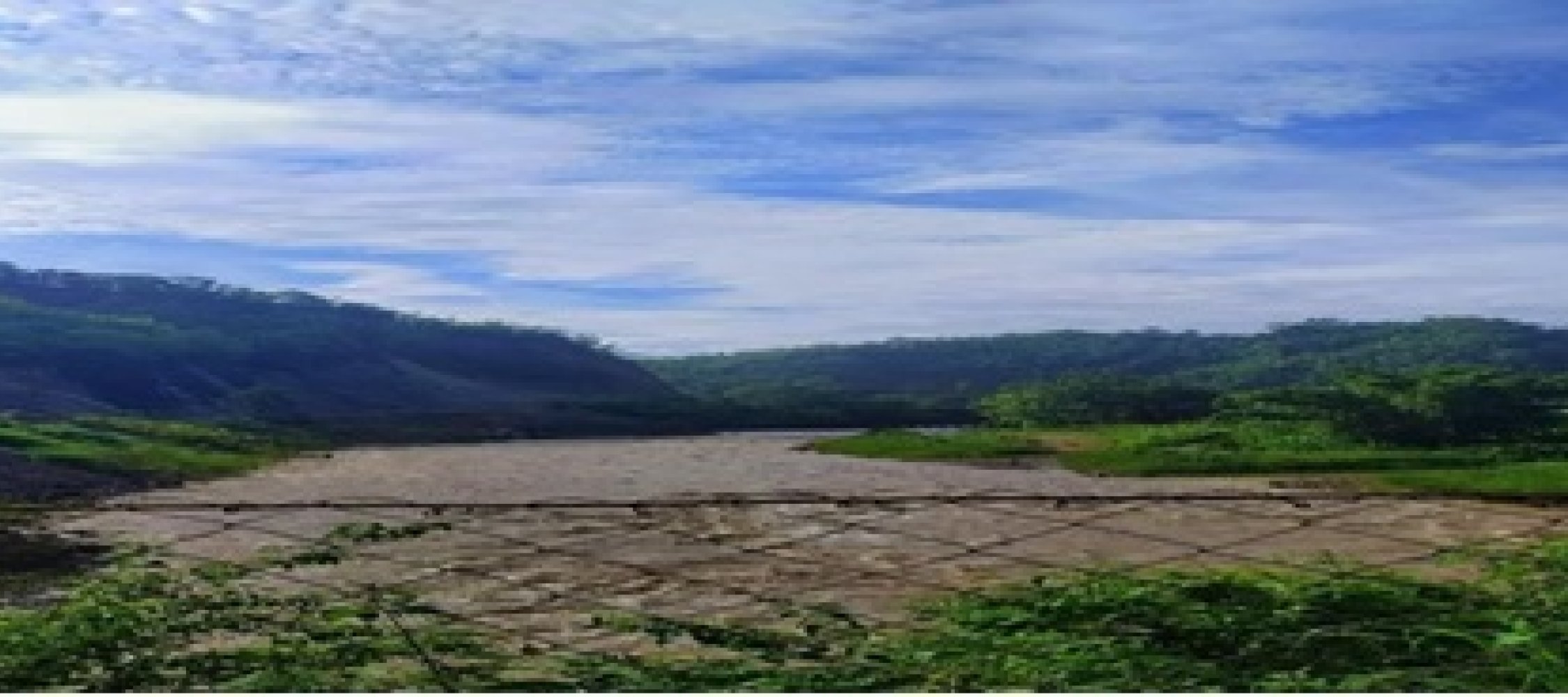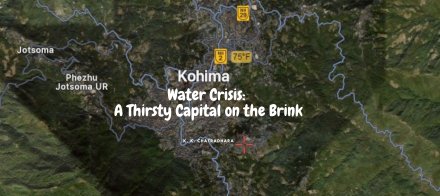 |
YUNGTZE - A TALE OF RIVERS - Memories of the Chathe river
Nagas have a very apt word for river stories –‘Yungtze’! I became pleasantly aware of the real meaning of the word, Yungtze, when I sat down one evening with my friend’s grandfather to talk about his childhood memories. “Oh, there is so much to tell,” he smiled, as he affectionately gazed at me. His wrinkled face conveyed years of hard work and experience. “I grew up along the Chathe river. In the hot, sultry summer, we had a great time swimming and playing with my friends in the sparkling cool waters of Chathe,” he said. It was the lifeline for the entire village; as if the whole village life revolved round the river – from drinking water to washing clothes and taking bath to fishing, he recalled. For many families fishing was the source of their livelihood. “But all of this has gone forever,” he sighed with a heavy heart.
I realised much of what he spoke of his young days was almost like singing paean to the Chathe river. This is what Nagas call Yungtze – “a tale of rivers”, which is expressed in diverse Naga dialects. As the grandpa continued with his narrative, I felt that indeed every river conjures up all kinds of happy and tragic memories associated with certain incidents and their impact on the lives of the communities living by the river side.
The Chathe, also known as the Diphu river, originates in the uplands of Medziphema, which drains the alluvial plains of the Dimapur district towards north, accumulating waters from several streams flowing out from the southeastern spurs. The river has three main sources: The first source flows from Jaluki, the second from Pherima, and the third from Jharnapani mountain area.
Dimapur, said to be the capital of the ancient Kachari/ Dimasa kingdom, is almost flanked by two main river systems – Dhansiri, which flows from the southwest of Dimapur town and runs towards the northern direction, and Chathe (Diphu river), which flows from the southeastern flank. Numerous streams from the southern hills carry with them sand and gravels that get deposited in the plains of Dimapur valley; both the rivers eventually meet in the Golaghat district of Assam and join the southern bank of the Brahmaputra.
Interestingly, in the Dimasa/ Kachari language the name, ‘Dima-pur’, suggests a land having a river flowing by it. The general topography of the district consists of broadly two features – the alluvial plains in the north and uplands with scattering of low-lying hills with maximum elevation of 260 metres above mean sea level in the southern regions. The two major river sub-basins of Dhansiri and Chathe of the district also shaped other land and waterscapes, such as wetlands; there are over 200 wetlands, which include marshy lands and ponds, covering an area of about 2,000 hectare. The district receives an average annual rainfall of 1200-1500 mm, and the annual temperature sways between 9 to12 degree Celsius (December-January) and 32 to 37 degree Celsius (May-June).
Dimapur also serves as the gateway to Nagaland and Manipur and is the largest trading and commercial hub of the state, with a multi-ethnic and cultural population of 3.79 lakhs (2011 Census); nearly two lakhs people (34 per cent) live in and around the urban areas of Dimapur with a population density of 410 per square kilometres (sq km). The Chathe river also forms the boundary between Nagaland and Assam.
Chathe: the soul of Dimapur
The Chathe river flows through the heart of the bustling business city of Dimapur. Naturally, in the context of burgeoning population, expanding urbanisation, the growing demands for drinking water, and other domestic and industrial needs, the Chathe river fulfills multiple needs of the city, especially of those who depend on it for their daily needs.
Fishing is one of the most common activities that can be noticed along the riverside. Many local people also gather snails and other edible aquatic plants. Every morning women, young boys and girls head for the river carrying small fishing nets and traps to try their luck in fishing. Elders said with fond nostalgia that in the past hundreds of people lived on fishing and collecting snails from the Chathe river. They got enough fish for both consumption and sale. However, they said, the quantity of catch drastically declined due to river pollution and overexploitation. According to them, there are some unscrupulous people who use various means such as, excessive usage of poisonous chemicals (bleaching powder, limestone, tython, etc.), which temporarily stun and immobilise fish in the river or any stream.
People also have observed some changes in the behaviour of the river, triggered by extreme weather events. That is why, perhaps, locally it has earned a new name, pagla nadi, meaning ‘frantic river’ as the Chathe has claimed many lives during these past few years.
Ailing Chathe:
A study by a team from the University at Dimapur revealed that numerous human activities were adversely affecting the quality of water and the aquatic life of the river. One of the major problems, the team found out, was the bio-medical wastes of the Christian Institute of Health Science and Research Centre (CIHSR) that went into the river. This poses a serious threat of chemical contamination of river water, fish fauna and other aquatic life. The use of such polluted water and consumption of fish and snails from the river may eventually turn into major human health hazards. This calls for immediate attention and remedial action.
Besides, there is another issue – the urban waste disposal of the city. It appears that the Chathe river has become an easy ‘dumping ground’ for all wastes from the city, including the neighboring villages such as the Naga United Village (NUV) and Diphupar. When asked about it, an NUV council leader said: “Our villagers are not quite aware of this way of polluting the river. We have also not received any complaints from government departments like the State Pollution Control Board. So, we are just dumping everything into the river.” He, however, admitted that the village should have a waste management committee to address this problem.
Among other disturbing things about the river’s pollution is the carelessness of the local youth who gather by the river side in the weekends for merry making and picnic. After all fun and drinking, they leave trails of food wastes, tin cans and bottles all over the riverside, which end up in the river.
Sand Mining:
Apart from aquatic flora and fauna, Chathe also offers other materials, especially sand, stone chips and boulders, which are used for construction and infrastructure development. All these are the free gifts that hilly rivers carry along. Humans have learnt ways of using them and converting the natural resources into economic goods and income (profit). As human greed knows no bound, these materials are exposed to mindless extraction and degradation. Though there are laws and rules for regulated use of these resources as well as environmental protection, they are seldom enforced. As a result, the Chathe river has become a victim of ravenous exploitation by sand mafias. For the last severa years, several organised groups have been mining sand and extracting boulders from the riverbed without any apparent government sanction. Hundreds of trucks laden with sands and boulders make their rounds along the Chathe river. When this writer made a spot visit to Ruzaphema area at 4th Mile locality of Dimapur, people spoke of the adverse impact of the unregulated sand mining and boulder extraction on the behaviour of the river. All this, they believed, caused intense soil erosion of riverbanks and affected the riverside ecosystem and infrastructure.
It’s not sand mining alone that is affecting the river; the irresponsible dumping of debris from the construction site of the Dimapur-Kohima four-lane highway project at Chumukedima is also contributing to the woes of the river. The Chumukedima village council (CVC) expressed its extreme displeasure to the contracted company for flouting all earth cutting and road building laws and rules, and dumping all kinds of debris into the Chathe river. This is choking the natural course of the river and creating unpredictable river behaviour. The CVC has raised this issue through media on several occasions but action has not been taken yet. In February 2017, this writer lost her nine-year-old cousin when he went to take a bath in the Chathe river. Apparently, he fell into the depth of a ditch created by sand mining in the river bed. Many families have reported of losing of their near and dear ones to these excessive stripping of the river.
The Dirge of river Chathe:
In July, 2017, four persons, including a minor boy, died when a bridge constructed over the Chathe river collapsed at 4th Mile of Dimapur. The bridge connects Dimapur to Niuland sub-division and Kohuboto circles that include more than 20 villages. The incident occurred in the evening. As the news of the incident spread, within an hour, the location was swarmed by people from all over the town. It was not known what led to the collapse of the bridge. Some people speculated that it was due to negligence of the contractor, while others blamed it on other factors such as river bed mining, which destabilised the river flow dynamics and weakened the river banks.
Local people also reported scary incidents of floating human bodies in the river from time to time. In August 2018, newspapers published a shocking report of sighting a human torso in the river near Chumukedima. The body was found decapitated and the limbs were also missing. In another report, police pulled out a strange-looking plastic sack from the Chathe and found a pair of new-born babies wrapped therein, which created a sensation in the area. Some passers-by heard of crying babies by the riverside, where they were taking their cattle for grazing.
Civil Society Initiatives:
There have been periodic efforts by various sections of the society to address some of the problems of the river Chathe. In December 2019, a local band, Abiogenesis, had organised a musical evening on the riverside at Howey Jungle, Nihito as a part of the Chathe River Festival. The idea was to recognise the importance of the river Chathe in the lives of the local communities as well as the urban dwellers, and at the same time, draw their attention to the problems of urban waste management and the river pollution.
A few years ago the Angler Association of Nagaland had attempted to clean certain stretches of the river Chathe to highlight the need for rejuvenation of the river and to help restore fish population.
_________________________
About the writers:
Tosangla C. Chang has done her a post-graduation in Social Work and specialised in Peace and Conflict Transformation Studies from North East Institute of Social Sciences and Research, Dimapur Nagaland (tosanglacchang@gmail.com, +918731940925)
Lakum C. Chang has done his post-graduation in Social Innovation and Entrepreneurship from the Rajiv Gandhi National Institute of Youth Development. He is an experienced all-rounder skilled in research, working with a diverse population, project management and planning. Result-driven and adept in driving the production from planning to execution, he has worked in various corporate, NGOs, CSR projects as well as social enterprises. When he isn't engaged in work or projects, he loves to read, travel, sing and write.
Imran Bahar Laskar from Guwahati has done his Post-graduation in Social Innovation and Entrepreneurship from Rajiv Gandhi Institute of Youth Development. He is a social entrepreneur working in the agricultural sector with a vision of uplifting the rural economy.


